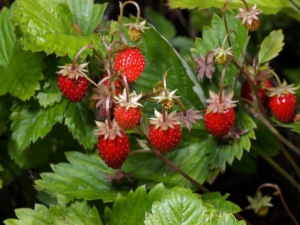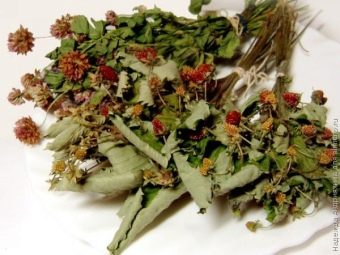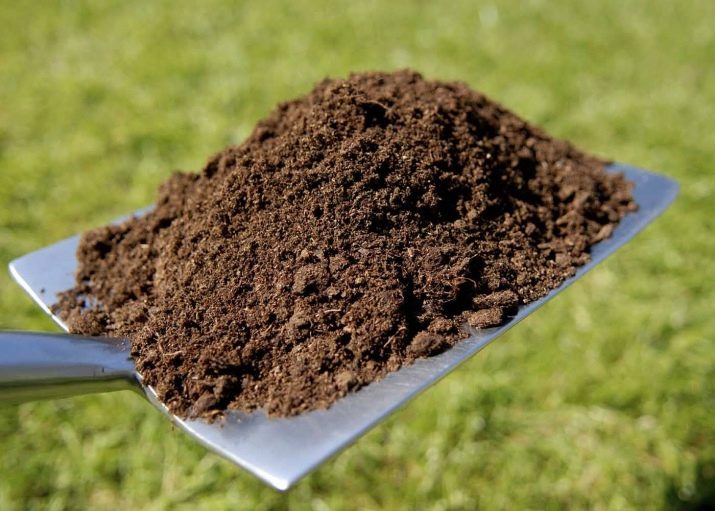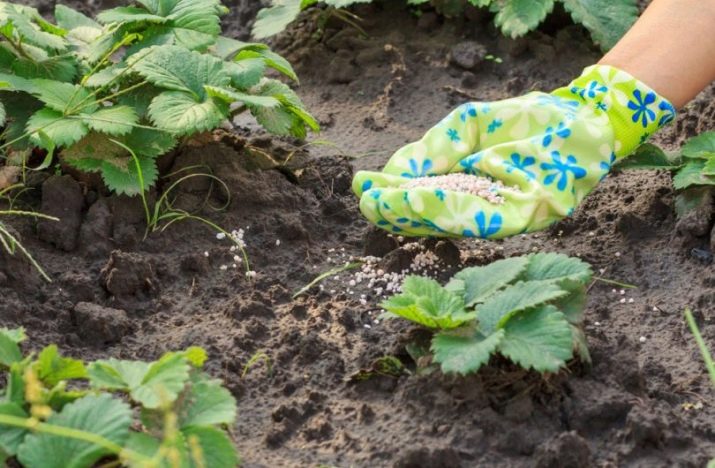Wild strawberry: features, cultivation and application

The world of the forest is diverse, and in the wild nature you can find many animals, birds, flowers, trees, as well as delicious berries. Forest strawberries are considered the most popular among them. She is beautiful, has a divine aroma and rich taste. It boasts healing properties widely used in traditional medicine.
Culture description
Botanical description of wild strawberry is a type of herbaceous plant of the Rosaceae family. The Latin name of this berry is Fragaria vesca. In literal translation from Latin, it may sound like wild strawberry. In the very name of the berries you can find the hidden properties of strawberries. Because of the short stem, the berries bend under their own weight, reach the surface of the earth and lie down gently on it. Even in ancient Russia, this very plant bore the name "strawberry".
The external parameters clearly stand out a straight stalk, the height of which varies between 20-22 cm. The leaves of the plant are lowered, resemble a rounded diamond. The color scheme is saturated with several shades, light and dark green. During the flowering period, strawberries are covered with small flowers with five petals, in the center there is a yellow hearth that looks like the sun. After some time, on the site of these charming flowers appear berries, the aroma of which extends over a long distance. Ripe fruit can be eaten.
The root system of strawberries has a horizontal structure with an oblique type of rhizome.
The flowering period of forest strawberries begins in May and flows smoothly in June. A month later, the berries begin to ripen. Initially, the fruit gives the main bush, and after his children, abducted from a mustache. The time to harvest the berry crop depends on several factors. Firstly, from the climate and weather conditions, secondly, from the landing site.
Common wild strawberry is very popular in almost every corner of the world. This berry is widespread in Siberia and the Urals. Belarusian and Ukrainian forests are covered with strawberry bushes.
Unlike other berries growing in nature, wild strawberry has a full range of vitamins and substances that are useful for the human body.
Benefit
Everyone knows that wild strawberry has a mass of healing properties. For a long time it is used in the compositions of the decoctions of traditional medicine. Not only strawberry berries are endowed with useful properties, but also the leaves of the plant. They make an excellent bactericidal agent, as well as anti-inflammatory, tonic and firming drugs.
The benefits of strawberry berries tested centuries-old observations of the medical industry. They can be consumed not only adults, but also children. And the presence of folic acid in the composition of berries makes it possible to talk about benefits for pregnant women. The ripe fruits of wild strawberries are able to restore a person’s energy balance, add strength and strengthen nerves.
Detailed description of useful properties:
- wild strawberry has a positive effect on human digestion, increases appetite, helps to assimilate the products obtained by the body, promotes their removal;
- A full complex of vitamins in the composition of strawberries is able to improve the human body and prevent the first signs of aging;
- wild strawberry helps to stop the cancer process;
- regular use of wild berries enriches the body with important trace elements;
- strawberry has a beneficial effect on the heart and cardiological picture as a whole;
- thanks to this berry, the human body is promptly cleansed of harmful toxins;
- strawberries for cosmetic purposes will help tighten the skin of the face, make it smooth and tender.
The root system of a strawberry bush is used to treat and prevent certain diseases:
- regular use of root tincture contributes to the rapid cleansing of the body from harmful toxins;
- strawberry root helps to cope with the problem of indigestion, and also has a positive effect on the kidneys and liver;
- decoction of strawberry root can thicken and restore blood, due to which it is used in the treatment of gynecological diseases.
Broths and infusions of strawberry leaves have a number of useful properties:
- strawberry leaf tea is considered the first treatment for colds, sore throat and cough;
- leaf tincture promotes vasodilation, thereby reducing blood pressure and increasing heart rate;
- decoction of strawberry leaves is used for the prevention of sclerosis;
- Each leaf has anti-inflammatory properties, so you can attach a leaf that has just been torn off onto an open wound.
Strawberries are distinguished not only by their taste, but also by a number of useful properties:
- regular consumption of ripe fruit increases appetite and quenches thirst;
- drinks with strawberries have a positive effect on the renal system;
- strawberry juice reduces blood sugar, which has a beneficial effect on the body of people with diabetes;
- Acid composition of berries provides dental care, prevents the occurrence of stones and fights bad breath in the mouth;
- berry face mask prevents pigment spots, whitens and moisturizes the skin.
Harm
Despite the impressive list of advantages, some elements of the composition of the berries can cause an allergic reaction. That is why allergies better to refrain from strawberry treatment, or start using the most minimal doses. It is important to know that eating strawberries on an empty stomach is not recommended, especially for pregnant women.
The general list of contraindications is small, but it should be carefully studied before proceeding to the process of use:
- gastritis;
- pancreatitis;
- renal colic;
- appendicitis;
- high level of secretion of gastric juice.
Growing in the garden
Each gardener and a gardener wants to grow wild strawberries on his plot. But for this it is not enough just to plant the plant and wait for the first berries to ripen. First you need to choose in the forest often grown bushes with large fruits.
It is important that the plants have a healthy appearance, do not suffer from natural diseases. Only after that you can transplant strong bushes to the country.
Landing
Spring is the most suitable period for planting wild strawberries. In summer, the transplanted bushes are adapted to the new environment, making it easier to survive the cold season. Planting can be done in the summer, but you must wait until the strawberries have completely bloomed.
Plant wild strawberries must be together with forest land. It should be noted that when digging up grown bushes one should be kind to the root system in order not to damage its branches.
Place for planting should have constant access to ultraviolet rays, but at the same time, plants need shade. In some cases, on the garden you can create an imitation of a forest thicket, for example, in the neighborhood, plant a fern that can protect the strawberries from the wind and slightly cover them from the sun.
During planting, some gardeners make a mistake and plant strawberries in elevated areas of the garden. This misstep can lead to the death of plants, because in summer the bushes do not receive the necessary moisture, and in winter due to the wind remain without snow cover and can completely freeze out.
Another important aspect when choosing a place to plant is the soil itself. Its composition should contain a sufficient amount of humus. This will require fertilizing the land with ordinary manure, using compost or humus. Dilution of fertilizer is necessary taking into account strict proportions: a full bucket of a natural type of fertilizer, 50 g of superphosphate and potassium sulphate - 30 g.The resulting mixture is designed for 1 m2 beds for strawberries.
It is necessary to plant wild strawberries on a cool day when it is raining or gathering on the street. Plants planted in the last days of July - early August or at the end of May - early June take root in the best way.
The distance between the planted bushes should not be less than 40 cm. Small holes are dug in the garden bed, plants dug out of the forest are lowered in them, covered with soil, which is tightly compressed.
Important advice that should not be neglected - during planting the roots of strawberry bushes must be carefully straightened.
After the planting process has been successfully completed, it is necessary to water the plants. One full bucket will be enough for 16-19 bushes.
Care
The difference in care between wild and garden strawberries is small and almost imperceptible. In the spring, dry leaves and antennae are removed from the bushes, using a small and sharp knife. Dry vegetation is burned.
Garden plantings require shelter with foil to protect embryos from temperature extremes, and forest bushes do not require these procedures, since their immunity is designed for temperature fluctuations.
An important factor in the care of forest strawberries is the treatment and loosening of the soil near the plants themselves. In the spring, the depth of loosening is 6 cm, 3 cm is enough for autumn. Adult bushes of wild strawberries should be spud.
Gardeners share tips and suggest that for large fruits it is required to water the bushes after the flowering process, after the harvest and at the end of the fruiting period. To consolidate the result, strawberry bushes must be additionally watered in the 15th to 20th of September, at the very moment when the budding of the flower buds begins.
In the issue of feeding you need to carefully follow the instructions. The first fertilizer process is carried out in the initial days of May. The process of making fertilizer does not take much time. It is required to mix 0.5 l of mullein in a ratio of 1: 6, 10 l of settling water, 60 g of superphosphate and 2 tablespoons of wood-type ash.
The second stage of fertilizing is required before the start of flowering of strawberries. The solution is prepared from 10 liters of water, three tablespoons of wood-type ash and two tablespoons of superphosphate.
The third dressing is carried out after the final harvest. The soil is abundantly watered and fertilizer is applied evenly to every square meter of land. To do this, you will need to mix 10 g of ammonium nitrate or 20 g of ammonium sulphate type. It is important to know that mineral fertilizers have analogues as slurry, which is diluted at a ratio of 1: 6. Fertilizer consumption should be 4-5 liters per 1 m2.
The fourth stage of feeding is carried out in the last days of August or in the first days of September. To do this, use the mineral type of fertilizers, which include 50 g of superphosphate and 25 g of potassium salt.
How does the culture reproduce?
The reproduction of forest strawberries can be done in several ways, the most popular of them is the division of bushes. This option is resorted to in the event of a colossal shortage of planting material or to transfer the beds to another place.
It is permissible to divide a bush when its age has reached 2-3 years. For transplantation selected the best quality bushes with a strong rhizome. These plants have a developed root system. Their adventitious roots are right at the base.
This breeding method can be produced in spring and autumn. Selected bushes are dug up and divided into parts, while it is necessary to show maximum accuracy and thoroughness. Each separated branch with a root will grow and become an individual bush.
Breeding by breeding is mainly practiced when breeding new varieties of berries. The peculiarity of seed reproduction is the transfer to the children of all the quality of the plant mother.
To collect the seeds choose large ripe fruits.The top layer, filled with seeds, is cut off with a blade. Then it is ground and sent to dry for several days. After this time, you must rub the dry film, separate the seeds and put them in a paper bag. Ready seeds must be stored at room temperature.
If the fruits are not large, then they can be dried completely and stored in the form obtained. And there is also a liquid method of extracting seeds using running water.
The shelf life of strawberry seeds is 4 years. This period can be used for new landings.
The third method of reproduction is done with the antennae of strawberry bushes. Their massive growth takes place at the end of July or the beginning of August. Forest strawberries in the first year of their life gives very few whiskers, and adult bushes begin to erect. During this period, strawberry sockets get the opportunity to produce creeping shoots. The total number of shoots ranges from ten to thirty pieces.
Cooking recipes
The peculiarities of the taste of strawberry berries, as well as their medicinal properties, are transmitted to humans even when cooked. Various dishes with strawberry base can be cooked for everyday use or prepared for winter.
The most tasty treat that adults remember from their childhood is marshmallow. The recipe for its preparation is quite simple, which allows modern parents to easily prepare a treat for their children.
It is necessary to take ripe strawberries, can be slightly crushed, and grind them through a sieve. It is important that the rubbing sieve is not metallic. The rubbed layer of strawberries in a container should be 1 cm high. The mass is applied to cleaned wooden planks, which have been previously greased with purified sunflower oil. The blank must be left in the sun until completely dry, after which a new layer is applied. The finished product is rolled up and wrapped in natural fabric. Dessert must be stored in a dry place.
A delicious and healthy dish will be confiture made from strawberries. Especially nice to enjoy this magical dessert in the winter evening. To make traditional confiture, you will need 1 kg of strawberries, 1 kg of granulated sugar and 1 cup of water.
Sugar is poured with water and boiled over medium heat to a state of syrup. After that, the resulting mass is added strawberries and boiled over a small fire. When a droplet of dessert is kept in one place and does not spread on a plate, the confiture can be considered ready.
The important fact is that thermal processing of berries does not affect their quality and vitamin composition. Jam just goes through a process of long cooking, but the berries remain as useful and nutritious. In addition, this dessert can be rolled up for the winter.
For winter harvesting, you need 10 kg of strawberries, 0.5 liters of water and 6 kg of granulated sugar. Berries need to carefully sort, wash and let them dry. It is important that only ripe fruits are used for jam. Prepared strawberries must be crushed in cooking tanks, pour water into the berry mass and put on a small fire. Berries should be boiled down and become soft. After that, the mixture is removed from the heat, granulated sugar is poured out, and the jam container is again sent to the fire.
Cooking time is approximately 25 minutes. Ready dessert should cool down a bit, after which it can be poured into prepared cans.
The presented recipes do not take much time, and strawberry dishes and desserts will be a great addition to any table.
How to grow wild strawberries, see below.






































